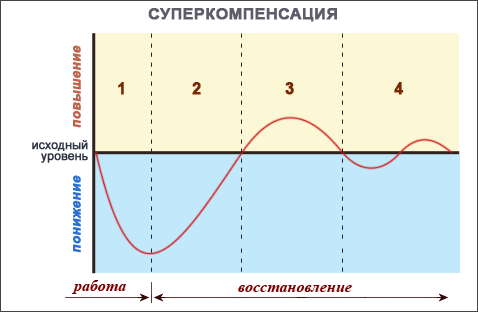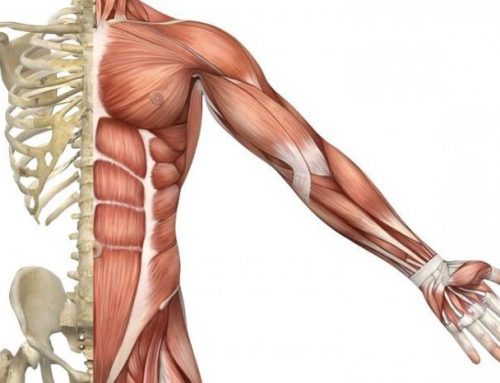Supercompensation phenomenon when restoring energy resources during the rest period:
1 – depletion phase ,
2 – recovery phase,
3 – phase of over-recovery,
4 – the phase of consolidated state.
The phenomenon of supercompensation is passing: after the phase of significant excess of the initial level, the content of substances gradually returns to normal (see the presented scheme).
The principle of supercompensation works as follows: the more you destroy structural and contractile proteins during training, the greater the excess of the initial level in the supercompensation phase. However, it’s not that simple, this rule is only applicable to a limited extent.
In excessively strenuous work, associated with very large destruction of muscle tissue, as well as with very large energy expenditure and accumulation of breakdown products, the rate of recovery processes may decrease, and the supercompensation phase will be reached at a later time and expressed to a lesser extent. It follows from this that maximum work is not always the best work.
There is a certain limit to the intensification of work, and once this limit is crossed, further improvement is very difficult. Working near the limit of intensity can be likened to walking on a razor blade – the slightest deviation in the direction of an even greater increase in intensity can lead to serious overloading of the body. When the body is overloaded, muscle mass gain is out of the question, as they say, “not to fat, to be alive”. And in the literal sense. Unreasonable constant increase in training load can lead to excessive use of internal resources that the body uses to ensure its vital activity. Such mistakes sometimes end in fatalities, even in experienced and well-trained athletes.
We will consider the issues related to controlling the intensity of training work in more detail a little later. For now, let us return to the question of what kind of work provides for the breakdown of contractile proteins to a greater extent.
As we found out earlier, the work of fast muscle fibers uses glycogen and glucose as a source of energy supply. During the process of glycolysis, intramuscular glycogen stores are broken down to lactic acid. The more intensely glycolysis is utilized, the more lactic acid accumulates in the muscle.
Then the following happens: with a significant accumulation of lactic acid the contractile properties of myofibrillar proteins deteriorate, there is a change in the osmotic pressure in the sarcoplasm of the muscle fiber and water from the intercellular medium enters the muscle fibers, causing their swelling. This whole process results in pain sensation.
This fact should be very well remembered – lactic acid accumulating in the muscles during exercise causes muscle pain.
And one more very important point should be canceled – there are two types of muscle pains, which must be distinguished:
- Pain that occurs in a muscle during exercise, which is caused by the accumulation of a high concentration of lactic acid in the muscle. This pain is felt as a burning sensation in the muscle doing the work. The greater the concentration of lactic acid in the muscle, the greater the burning sensation.
- Pain that occurs in a muscle 8-12 hours after exertion and peaks at an average of 24-72 hours. This type of muscle pain has its own name, delayed-onset muscle pain (DOMP), and this pain is caused by the processes of breakdown of structural and contractile proteins in the muscle. In other words, this pain is caused by breakdowns in the muscle tissue caused by the training load. We will look at this type of pain in more detail later.
At this point, we are close to the cause of muscle protein breakdown. I will draw your attention to the already mentioned fact – the accumulation of high concentration of lactic acid in the muscle, impairs the contractile properties of myofibrillar proteins.
Now read the following sentence with full concentration.
Performing muscle contractions under conditions of deterioration of contractile properties of myofibrils due to high concentration of lactic acid, leads to destruction of contractile proteins.
In other words, during exercise, you make a certain number of muscle contractions, and this leads to the accumulation of a high concentration of lactic acid in the muscle. Further muscle contractions performed against a background of high lactic acid concentration lead to the destruction of muscle structures. The higher the lactic acid content in the muscle, the greater the extent to which the muscle structures will break down with each subsequent contraction.
Hence, to maximize the destruction of contractile proteins in order to stimulate their subsequent super-recovery, it is necessary to perform such training work, which would significantly increase the concentration of lactic acid in the muscle.
The maximum concentration of lactic acid in muscle is usually noted after 40-45 seconds of muscle contractions, and work predominantly by glycolysis usually lasts up to 90 seconds. There is no further increase in lactic acid concentration because the active reaction of the internal environment (pH) shifts to the acidic side, there is inhibition of glycolytic enzyme activity, which reduces the rate of ATP formation. Decrease in pH also leads to disruption of nerve cell activity and development of guarding inhibition in them and impairment of excitation transmission from nerve to muscle.
This point should be considered in more detail. After the reserves of CrP in muscles begin to be exhausted and the rate of creatine phosphate reaction begins to decrease, glycolysis becomes more and more involved in the process of ATP resynthesis. The highest power of energy formation in the process of anaerobic glycolysis is achieved in exercises with a limiting duration of 20 to 40-45 seconds, then, as a result of lactic acid accumulation and decrease in intracellular pH, there is a decrease in the rate of glycolysis, so, after reaching the highest power by 40-45 seconds, there follows a period of power retention up to 60-65 seconds. By 60-65 seconds of extreme duration work, the maximum amount of lactic acid accumulates in the muscle. The maximum amount of lactic acid that may not be harmful to the body of a trained person is 2-2.5 g/L in the blood, and somewhat more in the muscles.
After reaching the maximum values of lactic acid accumulation in working muscles, the power of glycolysis begins to decrease and by 2-3 minutes of work the role of the main energy supplier is taken over by the aerobic process carried out in mitochondria.
Resummarizing all the above information, we can conclude that the greatest breakdown of protein structures occurs when performing work of maximum duration from 40 seconds to 65 seconds.
Here it is, the “Golden Mean” of bodybuilding – work of maximum duration from 40 to 65 seconds. By working with training weights that allow you to perform the maximum number of reps between 40 and 65 seconds, you will be stimulating your muscles to grow as much as possible.
In other words, what this all means is that when training to increase muscle mass, you should perform exercises with weights that will allow you to perform extreme muscle contractions for at least 40 to 45 seconds. This duration is the lower limit. The upper limit, which should not be crossed if you are interested in gaining muscle mass, is 65 seconds. In case you are able to perform an exercise with any weight for more than 65 seconds, you should increase the weight of the projectile.
- The next chapter: 7. Number of repetitions
- Previous chapter: 5. Increasing muscle cross-sectional area
- Beginning
The use of materials of the site in printed publications is possible only after obtaining written permission of the author of the site.






